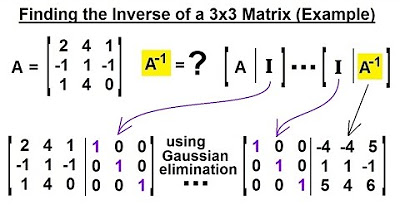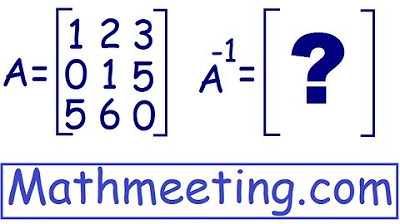PreCalculus - Matrices & Matrix Applications (22 of 33) Using Gaussian Elimin. to Find the Inverse
TLDRThis video script offers a comprehensive guide on finding the inverse of a matrix using the Gaussian elimination method. It explains the process step-by-step, starting with a 2x2 matrix example and discussing how to augment the matrix with the identity matrix. The video demonstrates each step of the Gaussian elimination process, including row operations to transform the matrix into the identity matrix, with the inverse matrix appearing on the right side. The script emphasizes the method's applicability to any n x n matrix and confirms the correctness of the obtained inverse by multiplying it with the original matrix to achieve the identity matrix.
Takeaways
- 📌 The lecture introduces a general method for finding the inverse of any n x n matrix.
- 🔍 The process starts by augmenting the matrix with the identity matrix.
- 📈 Gaussian elimination is used to transform the left side of the augmented matrix into the identity matrix.
- 🔄 The right side of the matrix becomes the inverse as the left side turns into the identity matrix.
- 👉 A step-by-step demonstration is provided using a 2x2 matrix example.
- 🔢 The first step involves dividing the first row by its leading element to get a '1'.
- 🗂️ Subsequent steps use row operations to manipulate the matrix into the desired form.
- ✅ The result is verified by multiplying the original matrix with the calculated inverse to obtain the identity matrix.
- 📚 The method is applicable to matrices of any size (2x2, 3x3, 4x4, 5x5, etc.).
- 🚀 For 2x2 matrices, this general method can be used, but there's also a quicker method from a previous lecture.
- 💡 The choice between methods depends on the size and nature of the matrix at hand.
Q & A
What is the main topic of the lecture?
-The main topic of the lecture is solving for the inverse of a matrix using a general approach applicable to any n by n matrix.
How does the process of finding the inverse of a matrix begin?
-The process begins by augmenting the matrix with the identity matrix.
What method is used to transform the left side of the augmented matrix into the identity matrix?
-The Gaussian elimination method is used to transform the left side of the augmented matrix into the identity matrix.
What happens to the right side of the augmented matrix when the left side becomes the identity matrix?
-When the left side becomes the identity matrix, the right side of the matrix becomes the inverse of the original matrix.
What is the first step in the Gaussian elimination process for finding the inverse?
-The first step is to make the first element of the left side of the matrix become 1 by dividing the first row by its leading element.
How is the second element of the first row made to become 0?
-It is done by replacing the second row with the negative of the second row multiplied by the row with the 1 in the first position and then adding it to the second row.
What is the purpose of the next step, which involves changing the second row to have a 1 in the second position?
-The purpose is to make the second row's second element become 1, which is achieved by multiplying the second row by 2.
How is the last element of the first row made to become 0?
-It is done by replacing the first row with the negative of the second row multiplied by the element with a 1 in the second position of the second row and then adding it to the first row.
What is the final result of the inverse matrix based on the example given?
-The final result of the inverse matrix, based on the example, is a matrix with elements 3, -1, -5, and 2.
How can you verify that you have found the correct inverse matrix?
-You can verify the correct inverse by multiplying the original matrix with the calculated inverse matrix and checking if the result is the identity matrix.
What are the two methods mentioned for finding the inverse of a 2x2 matrix?
-The two methods mentioned for finding the inverse of a 2x2 matrix are the Gaussian elimination method and the quick method shown in the previous video.
Outlines
📚 Inverse of a Matrix - General Approach
This paragraph introduces the concept of finding the inverse of a matrix using a general approach suitable for any n by n matrix. The process begins with a given matrix A, which contains elements 2, 1, 5, and 3. The method involves augmenting the matrix with the identity matrix and then applying the Gaussian elimination technique to transform the left side into the identity matrix, thereby making the right side represent the inverse of the matrix. A step-by-step demonstration is provided, starting with a two by two example, and the explanation includes the division of the first row by two, the transformation of the second row to achieve a zero in the first position, and the final step of obtaining the inverse matrix. The verification of the correct inverse is done by multiplying the original matrix with the calculated inverse to confirm that the result is the identity matrix.
🔢 Gaussian Elimination for Inverse - 2x2 Matrix
This paragraph continues the discussion on finding the inverse of a matrix, focusing on the 2x2 case. It emphasizes the flexibility of using either the general method introduced in the previous paragraph or a quicker method demonstrated in a prior video. The speaker expresses a preference for the quicker method due to its efficiency, especially for 2x2 matrices. However, the general method is highlighted as the best approach for larger matrices such as 3x3, 4x4, or 5x5. The paragraph concludes by reiterating the two available options for finding the inverse of a 2x2 matrix, providing learners with the flexibility to choose the method that best suits their needs.
Mindmap
Keywords
💡Inverse of a matrix
💡Gaussian elimination
💡Identity matrix
💡Augmented matrix
💡Row operations
💡Linear systems
💡Matrix multiplication
💡Two by two matrix
💡Row echelon form
💡Reduced row echelon form
💡Matrix elements
Highlights
The lecture introduces a general approach for finding the inverse of an n by n matrix.
The matrix A has elements 2, 1, 5, and 3, and the process involves augmenting it with the identity matrix.
Gaussian elimination is used to transform the left side of the augmented matrix into the identity matrix.
The right side of the matrix becomes the inverse after the transformation.
A step-by-step demonstration is provided using a 2 by 2 matrix example.
The first row is normalized to have a 1 in the first position by dividing by the first element.
The aim is to turn the off-diagonal elements into 0 using row operations.
Row swapping and multiplication are used to achieve the identity matrix form.
The inverse of the matrix is found to be 3, -1, -5, and 2.
Verification is done by multiplying the original matrix with the found inverse to get the identity matrix.
The method is applicable to any size n by n matrix, making it highly versatile.
For 2 by 2 matrices, there are two methods available, and the choice depends on preference and efficiency.
The Gaussian elimination method is particularly useful for larger matrices.
The lecture provides a clear and detailed explanation suitable for learners at various levels.
The process is shown to be effective and reliable for calculating matrix inverses.
The lecture emphasizes the importance of verifying the result to ensure accuracy.
The example used in the lecture helps to illustrate the method in a practical and understandable way.
The lecture concludes by reinforcing the generalizability of the Gaussian elimination method for matrix inversion.
Transcripts
Browse More Related Video

Inverse of a 3x3 Matrix

PreCalculus - Matrices & Matrix Applications (23 of 33) Finding the Inverse of a 3x3 Matrix

PreCalculus - Matrices & Matrix Applications (28 of 33) Solving Sys of Linear Eqn with Inverse

Classic video on inverting a 3x3 matrix part 2 | Matrices | Precalculus | Khan Academy

Inverse of 3x3 matrix

PreCalculus - Matrices & Matrix Applications (19 of 33) What is an Identity Matrix?
5.0 / 5 (0 votes)
Thanks for rating: